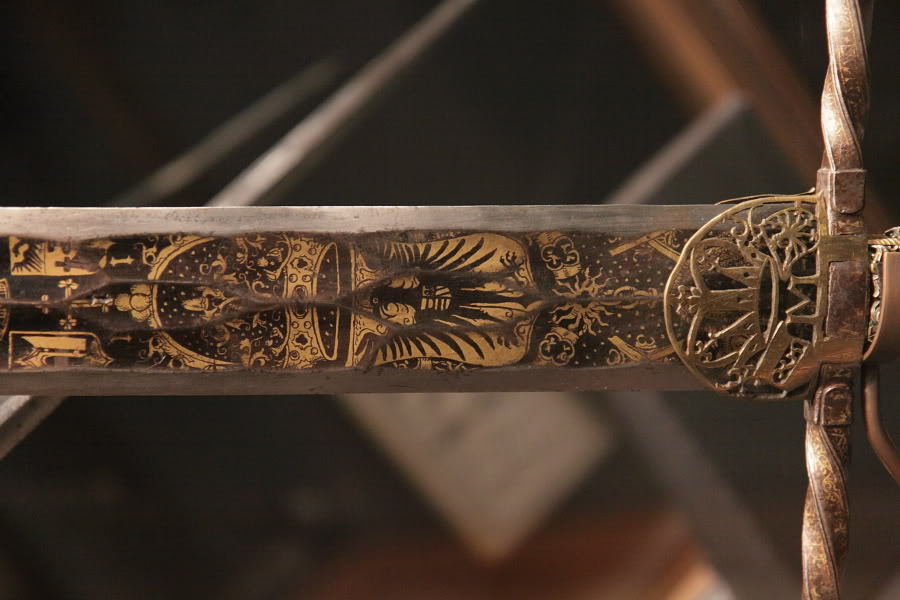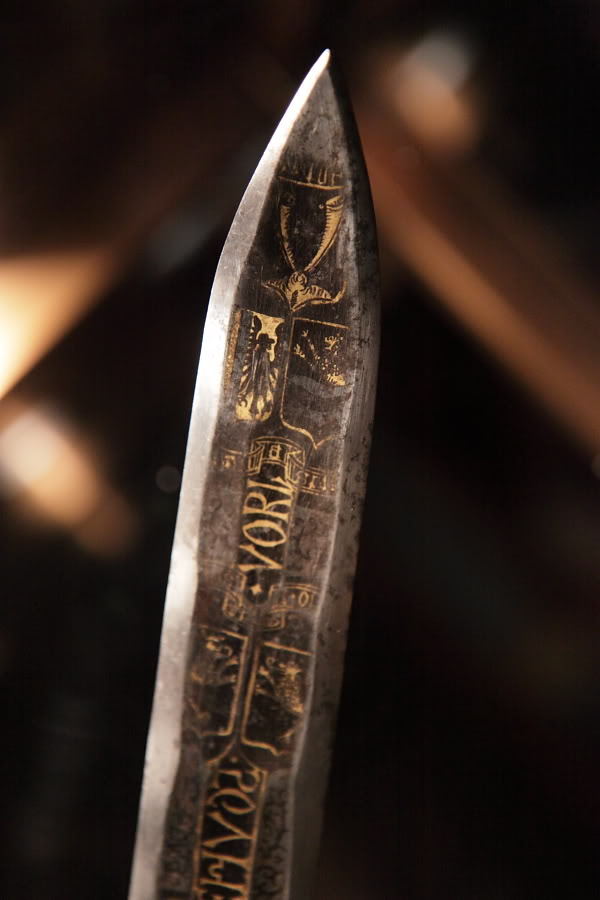| Author |
Message |
|
R.M. Henson
|
 Posted: Sun 16 Dec, 2012 6:51 am Post subject: Emperor Maximilian's Scalloped(?) longsword and messer Posted: Sun 16 Dec, 2012 6:51 am Post subject: Emperor Maximilian's Scalloped(?) longsword and messer |
 |
|
I was looking at two of Emperor Maximilian's swords, one a longsword and one a straight bladed kriegsmesser and noticed that the blades of these swords don't possess a fuller but instead have these long hexagon indentations extending from hilt to tip that for a lack of a better term resemble the look of a modern scalloped knife.


?

At risk of sounding like a fool I drew this comparison only because it has a loose similarity. But do these indentations serve any purpose other than looking stylish? Why don't any other swords bear this same style? Is there any more information on the sword like length or weight?
I can only hazard to guess that it somehow has the same effect of a more traditional fuller and adds stiffness, but it's only an uneducated guess.
Compagni of Schola St. George
http://www.scholasaintgeorge.org/
|
|
  |
 |
|
Peter Johnsson
Industry Professional
|
 Posted: Sun 16 Dec, 2012 8:58 am Post subject: Posted: Sun 16 Dec, 2012 8:58 am Post subject: |
 |
|
This "bee-hive" grind of interlocked hexagonal mini-fullers is a fancy way to achieve the same as one single shallow fuller or several narrow groves will do for a blade: reduce weight without reducing stiffness to the same amount.
A fuller does not increase stiffness. It makes the blade *less* stiff compared to a blade of the same width and thickness. It does remove mass from the middle, while saving the high spots on each side of the fuller. It is the distance from the neutral plane (through the edges of the sword) that gives stiffness. The further away from the neutral plane you get the ridge or mid flat of a blade, the stiffer it will be. A hollow ground blade with high midrib is another solution: you divide the fuller and put it on each side of the midrib, instead of the middle of the blade.
Different solutions ups will naturally lend themselves to blades with certain characteristics.
By the end of the 15th century and especially in the 16th and early 17th century you start to see very fancy combinations of groves, fullers and hollow grinds in blades. I think this is a result of that blade grinders started to come into their own as a group of specialized craftsmen in the manufacture of swords.
-A way to showcase the skill of the makers(-s) and develop new opportunities for aesthetic expression in blades, possibly in the hope to be able to fetch a better price for your work.
By the 17th century (perhaps earlier?) in Solingen it was the grinders of blades that reaped most of the fame in blade manufacture, not the blade smiths.
This is perhaps a bit odd to us today who are used to celebrate the skill of the blade smith, and sometimes even look down upon grinding: ground to shape does not sound half as interesting as forged to shape. Despite the fact that both forging and grinding takes skill and dedication to do well.
|
|
   |
 |
Luka Borscak

|
 Posted: Sun 16 Dec, 2012 2:23 pm Post subject: Posted: Sun 16 Dec, 2012 2:23 pm Post subject: |
 |
|
|
Peter, it might be a little off topic, but I noticed that you sometimes mention "second grade" Passau blades (for example in the thread about long gripped Swedish longswords). Does it mean second grade material or heat treat which would affect durability, or second grade finish (good blade messed up by an inexperienced grinder/polisher)?
|
|
  |
 |
|
Peter Johnsson
Industry Professional
|
 Posted: Sun 16 Dec, 2012 2:47 pm Post subject: Posted: Sun 16 Dec, 2012 2:47 pm Post subject: |
 |
|
Hi Luka,
What is noticeable is that some swords are obviously less carefully made: the tang is not centered, fullers wander wildly and are very uneven, blades are not very straight and so on.
Even on fine quality swords, you will find asymmetrical features, but not to the degree that these swords show.
Ada Bruhn Hoffmeyer has remarked on the fact that many of the swords with Pretzel-shaped guards and small spherical pommel that were popular in scandinavia in the 15th century are mounted on Passau blades that seems to be of second rate quality. The hilts for these swords were of local manufacture, while the blades were imported.
I do not know if a comparison of the metallurgy of these second rate swords and the best quality blades have been made, so I cannot say anything about that aspect of their quality.
Hope this helps!
|
|
   |
 |
|
R.M. Henson
|
 Posted: Sun 16 Dec, 2012 6:19 pm Post subject: Posted: Sun 16 Dec, 2012 6:19 pm Post subject: |
 |
|
Thanks Peter for clearing that up for me. I'm glad that it is functional not purely a decorative component. I had read that it was somewhat of a ceremonial sword, so I wasn't sure if it was meant to be functional.
So these were ground then? My initial assumption was that they were forged, but it makes sense. I can imagine forging all of those honeycomb patterns might have been more trouble than it was worth.
Compagni of Schola St. George
http://www.scholasaintgeorge.org/
|
|
  |
 |
|
Peter Johnsson
Industry Professional
|
 Posted: Mon 17 Dec, 2012 12:42 am Post subject: Posted: Mon 17 Dec, 2012 12:42 am Post subject: |
 |
|
| R.M. Henson wrote: | Thanks Peter for clearing that up for me. I'm glad that it is functional not purely a decorative component. I had read that it was somewhat of a ceremonial sword, so I wasn't sure if it was meant to be functional.
So these were ground then? My initial assumption was that they were forged, but it makes sense. I can imagine forging all of those honeycomb patterns might have been more trouble than it was worth. |
Yes, even if blades were forged to shape there is a lot of grinding and scraping involved in blade manufacture. Enough so, that there was need for a specialized cadre of craftsmen that were blade grinders.
If a blade is forged to 80% of finished shape, the last 20% of shaping is still a lot of grinding: all surfaces, all detials and all volumes have to be taken into consideration by the grinder: there is nothing that comes automatically just because there is a forged blade blank that is the starting material.
I am not sure how early this specialization of craftsmen was established, but by the 11th century sword cutlers were established in German towns as a specialized group. This hints at a situation where you also have specialized sub contractors who deliver parts or only works on certain aspects of production.
The fact that grinding is an important part of blade making can actually be a help in seeing the difference between genuine antique swords and some less well made fakes. Sometimes it is very obvious that what may at first look like surface pitted by rust in fact is a patinated forged surface left raw from the hammer (subsequently aged by acid etching and rusting/blackening). If you learn to see the difference between the unevenness typical for grinding and the typical surface left by the hammer, it can be strikingly obvious.
|
|
   |
 |
Luka Borscak

|
 Posted: Mon 17 Dec, 2012 5:16 am Post subject: Posted: Mon 17 Dec, 2012 5:16 am Post subject: |
 |
|
| Peter Johnsson wrote: | Hi Luka,
What is noticeable is that some swords are obviously less carefully made: the tang is not centered, fullers wander wildly and are very uneven, blades are not very straight and so on.
Even on fine quality swords, you will find asymmetrical features, but not to the degree that these swords show.
Ada Bruhn Hoffmeyer has remarked on the fact that many of the swords with Pretzel-shaped guards and small spherical pommel that were popular in scandinavia in the 15th century are mounted on Passau blades that seems to be of second rate quality. The hilts for these swords were of local manufacture, while the blades were imported.
I do not know if a comparison of the metallurgy of these second rate swords and the best quality blades have been made, so I cannot say anything about that aspect of their quality.
Hope this helps! |
Thanks, it helps. I hope someone will make some metallurgy tests on these blades.
|
|
  |
 |
|
|
You cannot post new topics in this forum
You cannot reply to topics in this forum
You cannot edit your posts in this forum
You cannot delete your posts in this forum
You cannot vote in polls in this forum
You cannot attach files in this forum
You can download files in this forum
|
All contents © Copyright 2003-2025 myArmoury.com — All rights reserved
Discussion forums powered by phpBB © The phpBB Group
Switch to the Basic Low-bandwidth Version of the forum
|

